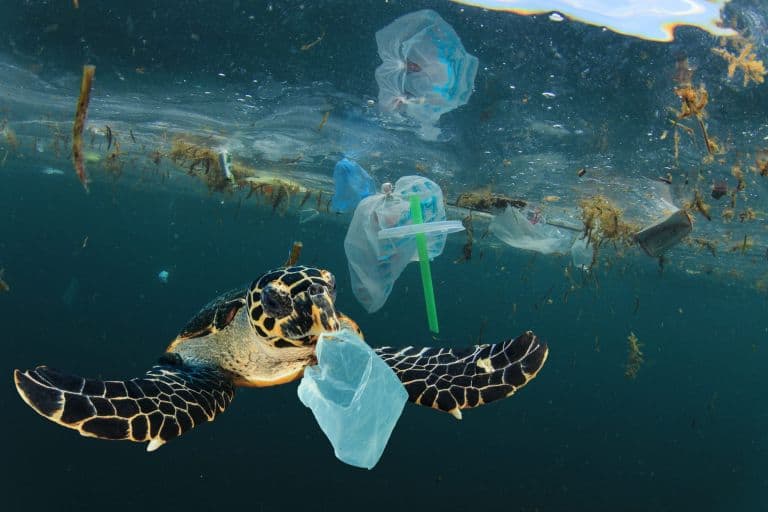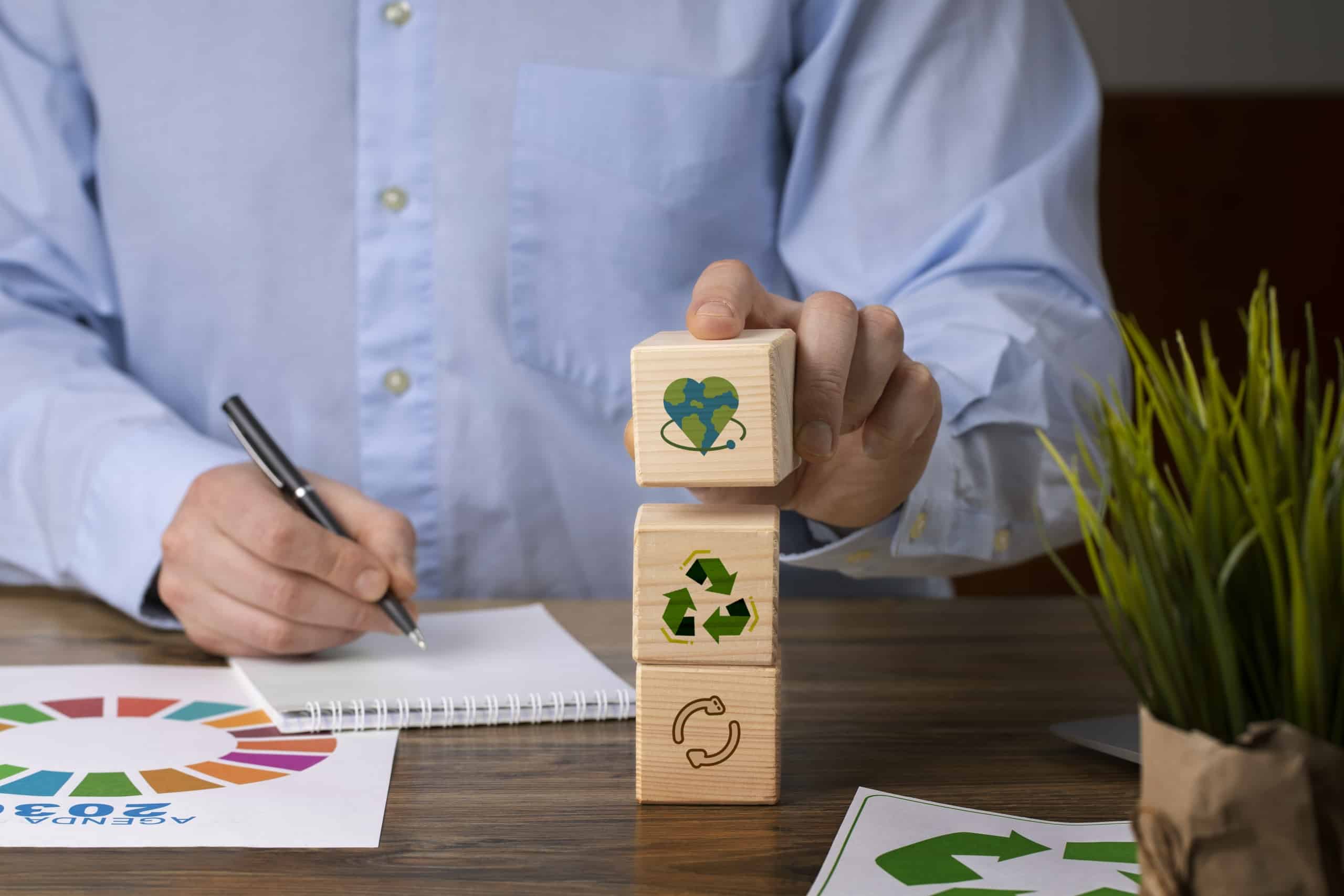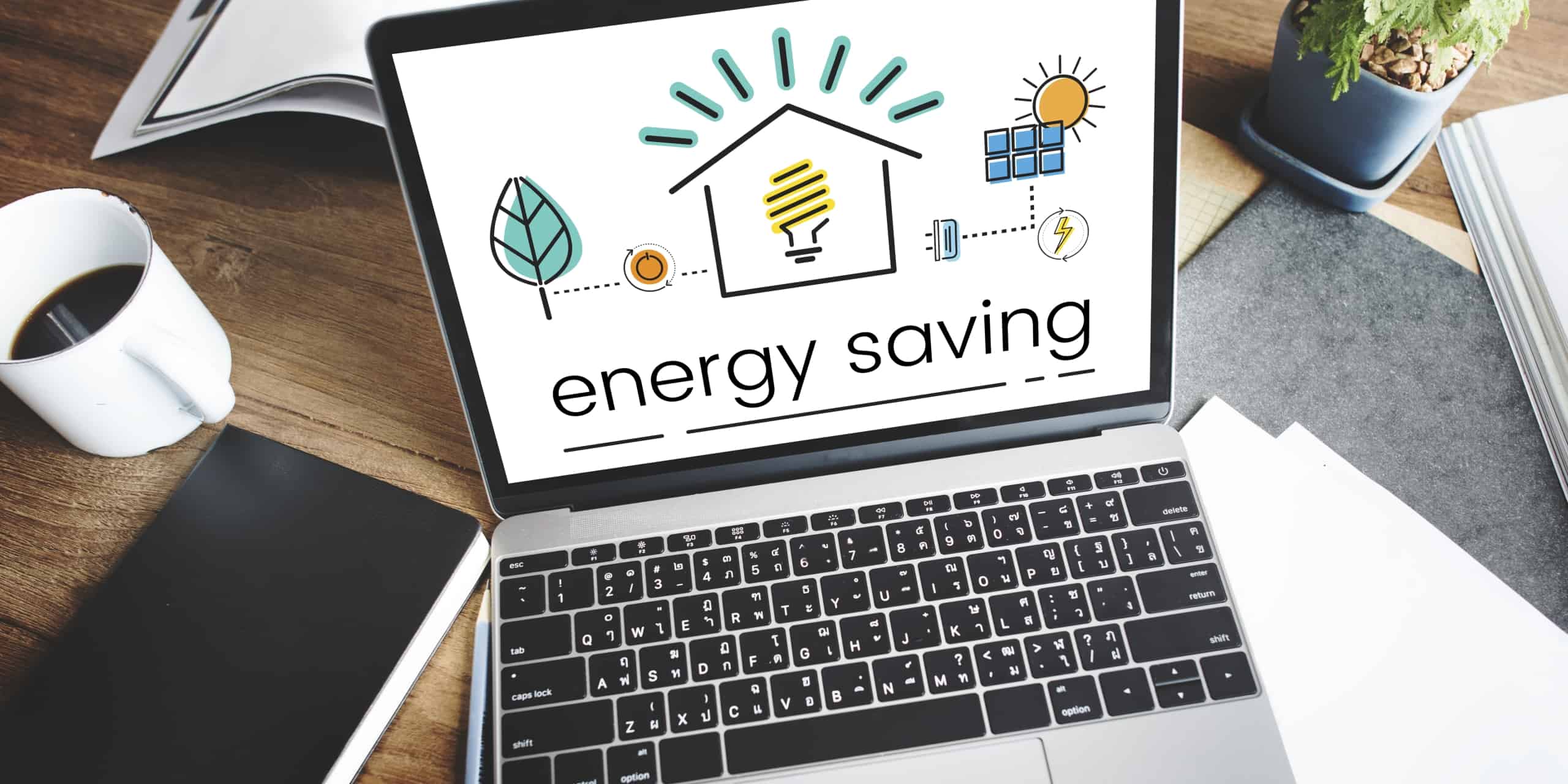What is The Environmental Challenge?
Conventional wet wipes, often found in homes, medical facilities, and many sectors globally, pose a notable environmental problem because of their makeup and disposal methods. These wipes, usually composed of synthetic fibers such as polyester and polypropylene, are non-biodegradable and do not easily break down in the environment. They endure for long durations, leading to pollution and environmental harm.
Improper disposal of conventional wet wipes, such as flushing them down toilets or throwing them in landfills, may have significant negative impacts on ecosystems and public health. Accumulations in sewage systems may cause blockages, resulting in expensive repairs and dangerous sewage spills into aquatic bodies. Marine organisms are especially susceptible to wet wipes pollution since these products often find their way into seas and water bodies, where they may ensnare animals or be swallowed, resulting in injury or fatality.
Moreover, the production of conventional wet wipes requires the use of finite resources and results in the emission of greenhouse gases and other pollutants. Every phase of the lifecycle, from raw material extraction to final product manufacture and transportation, adds to environmental harm and carbon emissions.
Traditional wet wipes provide an environmental problem that goes beyond immediate pollution worries to include wider considerations about sustainability and resource management. The rising worldwide usage of disposable hygiene products is putting strain on limited resources and worsening environmental issues including deforestation, habitat loss, and climate change.
To tackle this environmental issue effectively, we need to focus on implementing and promoting sustainable alternatives via a comprehensive strategy. Wet wipes machines are crucial technology that allows for the manufacturing of environmentally friendly wipes made from biodegradable and compostable materials. Wet wipes manufacturers can reduce the environmental effects of wet wipes and help create a cleaner, healthier world for present and future generations by switching to sustainable alternatives.
How Eco-Friendly Solutions Rise?
The hygiene business is shifting towards eco-friendly solutions due to increasing environmental concerns and customer preference for sustainable products.
- Biodegradable Materials: Biodegradable materials, such as polyester and polypropylene, are often used in traditional wet wipes and are not environmentally sustainable. Wet wipes machines now allow wet wipes manufacturers to use biodegradable and compostable materials in wet wipes manufacturing process. These materials, sourced from renewable elements like bamboo, cotton, or cellulose, provide a more eco-friendly option. Biodegradable wipes naturally decompose over time, decreasing their environmental impact and eliminating pollution issues linked to conventional wipes.
- Sustainable Manufacturing Practices: Sustainable manufacturing practices are promoted by wet wipes machines via the use of biodegradable materials. The wet wipes machines are created to maximize resource efficiency, limit waste output, and decrease energy use in the wet wipes manufacturing process. Utilizing advanced technology in wet wipes machines enables accurate management of production parameters, leading to effective use of resources and energy. Some wet wipes machines have energy-saving features like automated shut-off mechanisms and efficient heating systems to improve their environmental efficiency.
- Circular Economy Initiatives: Wet wipes machines support efforts to promote a circular economy in the hygiene business. Wet wipes manufacturers may help reduce resource consumption and waste creation by switching to eco-friendly products and sustainable manufacturing techniques. Biodegradable wipes made using wet wipes machines may be composted after use, enriching the soil and reducing landfill pressure. The transition to circularity decreases environmental harm and fosters innovation and economic expansion.
- Consumer Preference for Sustainable Products: Consumer preference for sustainable products is rising as knowledge of environmental concerns grows, leading customers to seek eco-friendly options when making purchases. Biodegradable wet wipes made by wet wipes machines are available to suit the need for environmentally friendly goods. Wet wipes manufacturers may influence customer preferences toward sustainable consumption by providing eco-friendly choices. The trend towards sustainability is spurring innovation in the hygiene sector, with wet wipes machines playing a vital role in facilitating the manufacturing of environmentally friendly products.
Eco-friendly solutions in the hygiene business are advancing due to advancements in wet wipes manufacture enabled by wet wipes machines. Wet wipes manufacturers are leading the way towards a more ecologically friendly future by adopting biodegradable materials, sustainable production techniques, and circular economy initiatives. Wet wipes machines will be crucial in meeting the increasing customer demand for sustainable goods and facilitating the shift towards a cleaner, healthier earth.
What is The Role of Innovative Technology?
Wet wipes machines embody advanced technology and technical innovation, transforming the wet wipes manufacturing process of hygiene goods. These wet wipes machines use sophisticated automation, precise control systems, and material science advancements to enhance production efficiency and environmental sustainability.
- Automation and Robotics: Modern wet wipes machines have sophisticated automation and robotics technologies that optimize production processes and reduce the need for human involvement. Automated systems perform material feeding, cutting, folding, and packing processes accurately and quickly, guaranteeing uniform product quality and reducing mistakes. Robotics technology allows for accurate and efficient manipulation of fragile materials, minimizing waste and optimizing resource use in the wet wipes manufacturing process.
- Precision Control Systems: The wet wipes machines use advanced control systems to accurately adjust production parameters including moisture content, temperature, and pressure. According to strict quality criteria, these methods guarantee consistency in product attributes including texture, thickness, and absorbency. Manufacturers may improve resource use, eliminate material waste, and limit environmental effects by adjusting production factors.
- Material Science Innovations: Advancements in material science are essential for creating environmentally friendly wet wipes made by wet wipes machines. Wet wipes manufacturers have led the way in using biodegradable and compostable materials sourced from renewable elements like bamboo, cotton, or cellulose. The materials provide similar performance to conventional non-biodegradable fibers but with a much reduced environmental footprint. Advanced material science advances enable the creation of sustainable packaging solutions that improve the eco-friendliness of wet wipes goods.
- Energy Efficiency: Energy efficiency is a primary consideration in the design of wet wipes machines, with manufacturers integrating technology to lower energy use and decrease environmental impact. The machines use energy-efficient components such variable frequency drives, high-efficiency motors, and insulating materials to maximize energy efficiency. Advanced heating and drying systems provide exact control over temperature and humidity levels, reducing energy loss in the wet wipes manufacturing process.
- Data Analytics and Optimization: Wet wipes machines are fitted with data analytics and optimization tools for real-time monitoring of production parameters and performance indicators. Wet wipes manufacturers may use data-driven insights to pinpoint inefficiencies, streamline production processes, and minimize resource use. Predictive maintenance algorithms aim to eliminate equipment downtime and save maintenance expenses, guaranteeing continuous functioning and optimizing production.
Ultimately, wet wipes machines represent the integration of advanced technologies designed to revolutionize the hygiene sector by improving efficiency and sustainability. By using automation, precise control systems, advancements in material science, energy efficiency techniques, and data analytics capabilities, these machines facilitate the creation of high-quality, environmentally friendly wet wipes with a reduced environmental footprint. Advancements in technology will make wet wipes machines crucial in promoting good change and determining the future of hygiene product production.
What is Sustainable Practices?
The hygiene business is progressively embracing sustainable approaches to reduce its ecological impact due to environmental concerns and regulatory challenges. Wet wipes machines with modern technology and unique features are essential for promoting sustainable practices. Here are the main sustainable behaviors facilitated by wet wipes machines:
- Biodegradable Materials: Biodegradable materials are a key sustainable practice enabled by wet wipes machines, allowing for their usage in wet wipes manufacturing. Conventional wet wipes, often composed of non-biodegradable materials such as polyester and polypropylene, contribute to environmental pollution and deterioration. Wet wipes machines allow producers to create wipes utilizing biodegradable and compostable materials sourced from renewable sources like bamboo, cotton, or cellulose. These materials biodegrade after disposal, decreasing the environmental effect of wet wipes and lowering pollution issues.
- Resource Optimization: Wet wipes machines are designed to enhance resource usage in the wet wipes manufacturing process by reducing waste and increasing efficiency. Advanced automation and robotics systems efficiently perform operations like material feeding, cutting, and packing with accuracy and high speed, which leads to less material waste and reduced resource usage. Precision control methods provide consistency in product attributes, enabling producers to create top-quality wipes with few deviations and flaws.
- Energy Efficiency: Energy efficiency is a primary concern in the design of wet wipes machines, with wet wipes manufacturers including technology to reduce energy use during wet wipes manufacturing. The machines use energy-efficient components such as variable frequency drives, high-efficiency motors, and insulating materials to maximize energy efficiency. Sophisticated heating and drying systems provide accurate regulation of temperature and humidity levels, which helps to minimize energy inefficiency and decrease environmental harm.
- Waste Reduction: Wet wipes machines aid in waste reduction by streamlining wet wipes manufacturing processes and minimizing material wastage. Automated systems perform material cutting, folding, and packing accurately, which decreases mistakes and minimizes the need for rework. Advanced quality control procedures guarantee that only top-notch wipes are packed and distributed, thereby decreasing waste and minimizing environmental effects. Some wet wipes machines have recycling mechanisms that allow for the reuse of specific materials, which helps decrease waste production and supports circular economy concepts.
- Environmental Certification: Wet wipes machine manufacturers often emphasize acquiring environmental certifications like ISO 14001 or EcoLabel to showcase their dedication to sustainability. These certificates confirm adherence to strict environmental standards and best practices, guaranteeing that wet wipes manufacturing methods minimize environmental effects and comply with legal requirements. Wet wipes manufacturers may boost their credibility and reputation as environmentally responsible firms by acquiring environmental certifications. This can attract environmentally concerned customers and increase the market demand for sustainable goods.
Ultimately, wet wipes machines enable many sustainable methods that reduce environmental harm and encourage ecological responsibility in the hygiene sector. Wet wipes manufacturers may create environmentally friendly wet wipes that align with customer desire for sustainable goods by using biodegradable materials, maximizing resource efficiency, limiting energy use, lowering waste production, and acquiring environmental certifications. Advancements in technology will make wet wipes machines essential for promoting good change and influencing the future of sustainable hygiene product production.
Why is Consumer Awareness and Demand Important?
Consumer awareness of environmental problems and sustainability has increased, leading to a desire for eco-friendly goods in several sectors, such as the hygiene industry. Wet wipes manufacturers are realizing the significance of meeting customer needs and are using wet wipes machines to provide sustainable alternatives. Consumer knowledge and demand are impacting the incorporation of eco-friendly techniques in the wet wipes business.
- Environmental Concerns: Consumers are becoming more conscious of the environmental effects of conventional wet wipes, especially their role in plastic waste and damage to ecosystems. With increasing public knowledge of concerns like marine pollution and plastic waste, customers are looking for options that reduce environmental damage. Increased awareness has caused consumers to choose biodegradable and compostable wet wipes made using sustainable production methods.
- Preference for Sustainable Products: Consumers increasingly demand items that reflect sustainability and environmental responsibility ideas. Eco-conscious shoppers choose items developed from renewable resources and produced using sustainable procedures. Wet wipes producers are meeting the demand for biodegradable wipes by investing in specialized machinery and using sustainable methods in manufacturing.
- Influence of Social Media and Education: Social media and internet platforms have had a notable impact on increasing awareness of environmental concerns and advocating for sustainable living habits. These channels are used by influencers, environmental campaigners, and organizations to educate customers about the environmental effects of common items, such as wet wipes. Consumers who are well-informed about sustainability are more inclined to favor eco-friendly choices and back businesses that show a dedication to environmental responsibility.
- Transparency and Labeling: Consumers are very interested in businesses providing clear information about the environmental effects of their products. Transparent labeling and certifications specifying the biodegradability, compostability, or sustainable production of wet wipes assist customers in making well-informed purchase choices. Wet wipes producers are meeting the need by acquiring environmental certifications and offering clear details about the ingredients and manufacturing methods utilized in their products.
- Influence on Brand Reputation: Sustainable goods may greatly influence brand reputation and market competitiveness due to consumer demand. Consumers see brands more positively if they promote sustainability and provide eco-friendly options instead of typical wet wipes. Wet wipes manufacturers may improve their brand image and appeal to environmentally concerned customers by investing in wet wipes equipment that can produce biodegradable wipes and using sustainable procedures.
Consumer awareness and demand for eco-friendly goods are causing substantial changes in the wet wipes business. Wet wipes manufacturers are investing in technologies that can produce biodegradable wipes and using sustainable methods in their wet wipes manufacturing process to meet these trends. Brands that value sustainability will be well-positioned to compete in the market and fulfill the rising need for eco-friendly hygiene products as customer tastes develop.
What is The Road Ahead?
The wet wipes sector is evolving in response to environmental concerns and customer demand for sustainable goods, with important trends and developments affecting its future.
- Technological Advancements: Technological advancements in wet wipes machines are projected to continue at a quick rate, resulting in enhanced efficiency, quality, and sustainability. Progress in automation, robotics, and precise control systems will help firms enhance production processes and reduce environmental harm. Furthermore, continuous research and development will concentrate on improving material science advances to broaden the variety of biodegradable materials for wet wipes manufacturing.
- Circular Economy Initiatives: The shift to a circular economy model will spur innovation in the wet wipes market, as producers prioritize reducing resource use and waste creation. This involves executing recycling and upcycling programs to reuse waste materials, creating goods that can be recycled or composted, and investigating alternative business strategies like product-as-a-service or refillable packaging choices.
- Collaboration and Partnerships: Collaboration among stakeholders along the value chain, such as manufacturers, suppliers, retailers, and regulatory agencies, is essential for advancing sustainable practices and advocating for eco-friendly solutions in the wet wipes business. Collaborating with academic institutes, environmental groups, and government agencies may help in exchanging information, transferring technology, and establishing industry-wide standards and best practices.
- Consumer Education and Engagement: It is crucial to educate customers about the environmental effects of wet wipes and the advantages of selecting eco-friendly options to promote the wider adoption of sustainable practices. Wet wipes manufacturers may use marketing efforts, social media interaction, and product labeling to increase awareness and enable customers to make well-informed purchase choices. Product transparency, certification programs, and customer incentives may encourage sustainable behavior and increase the market for eco-friendly wet wipes.
- Regulatory Compliance and Standards: Regulatory compliance and standards will impact the wet wipes business due to policies aimed at decreasing plastic waste and increasing environmental sustainability. Wet wipes manufacturers must keep up to date with changing rules concerning product labeling, packaging, and materials consumption to ensure compliance with environmental standards and certifications. Being proactive in engaging with regulators and industry groups may influence policy outcomes and create a favorable regulatory environment for sustainable innovation.
- Global Market Expansion: The rising demand for environmentally friendly wet wipes is not confined to certain countries or markets but is becoming a worldwide trend due to consumer consciousness and governmental mandates. Wet wipes manufacturers must adjust their product offerings and marketing tactics to accommodate various customer tastes and regulatory environments across different nations and regions. Increasing market access and distribution channels is crucial for reaching environmentally aware customers globally.
Ultimately, the future of the wet wipes sector will be defined by ongoing innovation, cooperation, and sustainability-focused projects. Wet wipes anufacturers can lead the transition towards a more sustainable future for wet wipes production and consumption by adopting technological advancements, and circular economy principles, engaging consumers, complying with regulations, and expanding into global markets.







